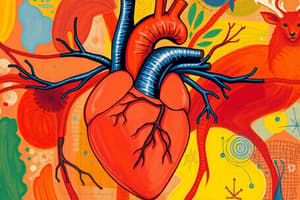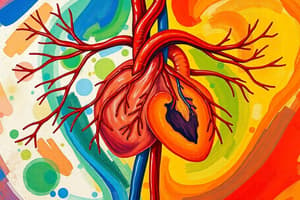Podcast
Questions and Answers
What is the primary function of the circulatory system?
What is the primary function of the circulatory system?
The circulatory system is responsible for transporting oxygen, nutrients, and hormones throughout the body, while removing waste products like carbon dioxide.
Describe the two main components of the circulatory system.
Describe the two main components of the circulatory system.
The two main components are the heart, which pumps blood, and the blood vessels, a network of tubes that carry blood throughout the body.
Explain the difference between arteries and veins.
Explain the difference between arteries and veins.
Arteries carry oxygenated blood away from the heart, while veins carry deoxygenated blood back to the heart.
What is the role of capillaries in the circulatory system?
What is the role of capillaries in the circulatory system?
Why is blood pressure important for the circulatory system?
Why is blood pressure important for the circulatory system?
Flashcards
Circulatory System
Circulatory System
The system responsible for transporting blood, nutrients, gases, and waste throughout the body.
Heart
Heart
The muscular organ that pumps blood through the circulatory system.
Arteries
Arteries
Blood vessels that carry oxygenated blood away from the heart.
Veins
Veins
Signup and view all the flashcards
Capillaries
Capillaries
Signup and view all the flashcards
Study Notes
Circulatory System in Mammals
- Mammals, including kangaroos and other marsupials, possess a closed circulatory system, meaning blood is contained within a network of vessels (arteries, veins, capillaries).
- This system is vital for transporting oxygen, nutrients, hormones, and waste products throughout the body.
- The system is composed of a four-chambered heart (two atria and two ventricles) that efficiently separates oxygenated and deoxygenated blood.
- The heart pumps blood through a network of blood vessels, ensuring precise and efficient delivery of essential substances.
- The presence of a double circulatory system (pulmonary and systemic) is a distinguishing feature, facilitating high metabolic rates and efficient gas exchange.
Features of the Circulatory System in Kangaroos
- Adaptations in the circulatory systems of marsupials, like kangaroos, reflect their unique physiology and lifestyle.
- The hearts of marsupials generally show similar structural components but proportions and specific adaptations differ.
- The need for efficient oxygen delivery during periods of high activity, like running or jumping, might influence cardiac function and blood flow regulation.
- Specialized vessels and pathways may be present within the circulatory system to support thermoregulation.
- Kangaroos, like most mammals, have arteries that carry oxygenated blood away from the heart to the body tissues and veins that return deoxygenated blood back to the heart. Capillaries facilitate the exchange of gases and nutrients at the tissue level.
- These circulatory adaptations allow kangaroos to maintain their high metabolic demands during physical activity.
Blood Composition and Function
- Blood consists of plasma (liquid portion) and formed elements (red blood cells, white blood cells, platelets).
- Red blood cells (erythrocytes) are crucial for oxygen transport. They contain haemoglobin, which binds to oxygen in the lungs and releases it in tissues.
- White blood cells (leukocytes) are part of the immune system, defending the body against infection and disease.
- Platelets (thrombocytes) play a role in blood clotting, vital for preventing haemorrhage.
- The composition and function of blood components in marsupials (like kangaroos) are likely similar to other mammals, exhibiting adaptations to meet species-specific needs.
Cardiovascular Regulation
- The circulatory system's function is regulated to maintain homeostasis; this is crucial for survival.
- Several control mechanisms, such as the nervous system and hormones, help sustain constant blood flow and pressure.
- The heart rate, blood pressure and blood vessel diameter are all regulated to match the body's demands.
- Mechanisms like baroreceptors and chemoreceptors monitor changes in blood pressure and gas levels, sending signals to the nervous system to adjust circulatory function.
Differences in Animal Circulatory Systems
- Comparative studies reveal adaptations in different animal groups, reflective of species-dependent needs and metabolic demands.
- Marsupials, like kangaroos, have evolved distinct circulatory features compared to other mammal groups, highlighting the adaptive power of biological systems.
Health Implications
- Issues with the circulatory system, like heart disease, hypertension, or blood disorders, can be serious for mammals, including kangaroos.
- Early detection and treatment of circulatory problems are critical for healthy survival.
- Investigating the specifics of circulatory function in different animals, including marsupials, provides valuable knowledge for understanding health issues and developing preventative measures.
Further Research
- The circulatory system in marsupials, like kangaroos, presents valuable opportunities for research on physiological adaptations and evolutionary pathways.
- Ongoing research may aim to further elucidate specific adaptations that help marsupials maintain metabolic balance and perform actions like rapid running and jumping.
- This detailed understanding of the circulatory system in various animal models can advance medical knowledge in relation to human cardiovascular function.
Studying That Suits You
Use AI to generate personalized quizzes and flashcards to suit your learning preferences.




